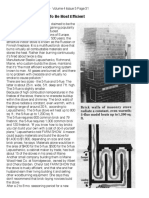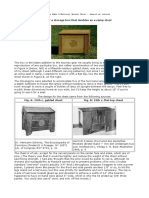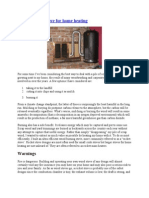Rocket Stove & Rocket Stove Heater
Rocket Stove & Rocket Stove Heater
Uploaded by
donx03Copyright:
Available Formats
Rocket Stove & Rocket Stove Heater
Rocket Stove & Rocket Stove Heater
Uploaded by
donx03Original Description:
Original Title
Copyright
Available Formats
Share this document
Did you find this document useful?
Is this content inappropriate?
Copyright:
Available Formats
Rocket Stove & Rocket Stove Heater
Rocket Stove & Rocket Stove Heater
Uploaded by
donx03Copyright:
Available Formats
ROCKET STOVE & ROCKET STOVE HEATER
How is a rocket stove different from a regular wood stove?
The goal of a rocket stove is to burn a relatively small amount of wood at as high a temperature as possible, resulting in more complete combustion, and to extract as much heat as possible from the exhaust gases. To generate high combustion temperatures, rocket stoves separate the combustion, heat extraction and exhaust functions.
Construction
Rocket stove mass heaters are often built from steel drums. These are convenient since they have a flat top that can also be used for cooking. I did not have one handy though. What I did have was my parents old electric hot water tank that they had just replaced since it was corroded and leaking. In addition to this I used some 3 diameter steel pipe, some 4x4 square tubing, and some flat steel plate, all about 1/8 wall thickness (though that is probably thicker than necessary). I also used some flexible aluminum tubing (dryer ducting) to feed the exhaust from the rocket stove into my existing fireplace.
Above is a picture of the internal parts of the stove (combustion chamber and chimney) set up for initial testing to make sure it would generate enough draft for vigorous combustion. The aluminum flex tubing is connected to the top of the chimney for testing only. In the finished product it will be connected to the side of the stove. The chimney is insulated with about 1 of Roxul (a rock wool insulation that will tolerate higher temperatures than fiberglass insulation) and wrapped with adhesive aluminum furnace tape to hold the insulation in place.
The above image shows the hot water tank cut to accept the combustion chamber and chimney.
The above image shows the combustion chamber and chimney being welded into the side of the hot water tank. Note the block of wood between the end of the chimney and the inside surface of the tank to ensure an appropriate gap for the exhaust gases. This piece of wood will be removed after the chimney is welded in place.
Mad scientist at work
and after a bunch more welding and a paint job that I neglected to take any pictures of viola! the finished product. The silver band around the bottom isnt a racing stripe. It covers the seam where I tack welded the bottom of the tank back on. I did not want to weld it on permanently since I may want to disassemble the stove later for inspection.
Notice that I removed a glass pane from the left door of my fire place and replaced it with cardboard. The aluminum flex tube passes snugly through a hole cut in the cardboard to expel the exhaust gases into the fireplace where, still warm, they rise and exit through the existing chimney. I know youre probably thinking I must be crazy to use a combustible material like cardboard for this purpose, but the fact is that the exhaust volume from this stove is so low and the stove is so efficient at removing heat from the exhaust that this aluminum tube reaches a maximum temperature of only about 60 degrees C during operation. Thats cooler than a typical cup of coffee. The top of the stove gets much hotter, of course.
I also made a simple metal screen that can be placed over the combustion chamber to prevent sparks from popping out into the room where they could ignite something (or more likely just leave burn marks as they smolder on the carpet). I have another cover, not shown, that is a solid steel plate. Its useful to quickly extinguish the fire and to prevent air infiltration when the stove is not in use.
Above is a photo of the cleanout. The plate which makes up the bottom of the combustion chamber is removable. I just slide it out as shown in the photo and the ash drops into any suitable receptacle (Im using a plastic tray above). Ive found it best to clean the ash out every week or so as once there is mor e than about a cup full it will fill the bottom of the combustion chamber and start to build up in the tube between the combustion chamber and the internal chimney. Then its a little harder to get to and it will eventually start to reduce the draft. In hindsight, access through the side of the combustion chamber instead of the bottom would have been more useful.
Savings
On average the heat energy available from burning wood is around 4.5 kWh per kg (assuming a 20% moisture content). Assuming roughly 80% efficiency of the stove (just a rough guess) the heat extracted will be about 3.5 kWh per kg. I heat my home with electricity that costs about $0.07 per kWh. Therefore,
the heating value of my scrap wood is about $0.25 per kg and by burning about 20kg per week I save about $5 per week on heating costs or about 50% of my heating bill for this time of year. Savings will be much greater in winter when the stove can be operated more frequently without the room becoming uncomfortably hot.
Why not just buy a fireplace insert?
I considered buying a fireplace insert but after learning about rocket stoves I quickly dismissed the idea because: 1. 2. 3. 4. 5. an insert would almost certainly be less efficient it would require significantly more cost and effort to install it wouldnt provide nearly the same conversation value I would not be able to re-purpose existing waste material such as my parents hot water heater it would not be portable (I look forward to operating my rocket stove on our patio on cool summer evenings).
You might also like
- Fact Sheet Rocket StovesDocument2 pagesFact Sheet Rocket StovesMorana100% (1)
- Kinetic Study of The Reaction Between Iron (III) Ions and Iodide IonsDocument11 pagesKinetic Study of The Reaction Between Iron (III) Ions and Iodide Ions门门100% (1)
- Quiz LEVEL 6 UNIT 5-1Document6 pagesQuiz LEVEL 6 UNIT 5-1ChloeNo ratings yet
- Masonry Heaters PDFDocument34 pagesMasonry Heaters PDFLucian Leonte0% (1)
- Gas Bottle Wood BurnerDocument13 pagesGas Bottle Wood BurnerGringgo KweeNo ratings yet
- Simplified Aquaponics ManualDocument16 pagesSimplified Aquaponics ManualkalgmNo ratings yet
- Cob Pizza OvenDocument26 pagesCob Pizza OvenBob BingoNo ratings yet
- En 1493 2010 Vehicle LiftsDocument66 pagesEn 1493 2010 Vehicle LiftsEylül Özdemir100% (1)
- TankDocument480 pagesTankduelsky100% (2)
- Chapter 1-Lesson 1 Understanding Technical WritingDocument22 pagesChapter 1-Lesson 1 Understanding Technical WritingMark David Francisco100% (1)
- Hannah StoveDocument14 pagesHannah StoveKurt LagerNo ratings yet
- The Spiral StillDocument27 pagesThe Spiral Stilldemo1967No ratings yet
- Build Your Own Solar Water HeaterDocument3 pagesBuild Your Own Solar Water HeaterRossen Ivanov100% (1)
- Rocket Stove Mass HeaterDocument11 pagesRocket Stove Mass HeaterTudor RomanNo ratings yet
- Build A Rocket StoveDocument10 pagesBuild A Rocket StoveCharmaine R. TaylorNo ratings yet
- Build A Rocket Stove For HomeDocument8 pagesBuild A Rocket Stove For HomePescaru Daniel100% (4)
- Rocket Stove Design Guide PDFDocument9 pagesRocket Stove Design Guide PDFEduardo EnriquezNo ratings yet
- Good Stoves Facilitation: How to Innovate and Change the WorldFrom EverandGood Stoves Facilitation: How to Innovate and Change the WorldNo ratings yet
- Twelve Plant Hydroponic Flood and Drain System: Parts ListDocument7 pagesTwelve Plant Hydroponic Flood and Drain System: Parts Listtraj17No ratings yet
- DiY Combination.Document5 pagesDiY Combination.dinkoxNo ratings yet
- Push Operated Spray Pump Cum Fertilizer Spreader Initial ReportDocument35 pagesPush Operated Spray Pump Cum Fertilizer Spreader Initial ReportAditu50% (2)
- Scott New Rocket StoveDocument44 pagesScott New Rocket StoveMio73Sto100% (4)
- !+++!+RocketStoveManual Web01Document32 pages!+++!+RocketStoveManual Web01Елена Гарусова100% (3)
- Blacksmith (Locally Available) : Stove MakersDocument11 pagesBlacksmith (Locally Available) : Stove Makersboim100% (1)
- Dan Chiras-Solar AquaponicsDocument75 pagesDan Chiras-Solar AquaponicsMamatha KamireddyNo ratings yet
- How To Cut Up A RabbitDocument13 pagesHow To Cut Up A RabbitkennyNo ratings yet
- Wood Chip Compost Water HeaterDocument25 pagesWood Chip Compost Water HeaterRoberto BekembauerNo ratings yet
- Cabin Stove Construction DrawingsDocument9 pagesCabin Stove Construction DrawingsStjepan Sony LeškovićNo ratings yet
- Trip Notes: Workshop On "The System of Free Gas Movement" With Igor Kuznetsov in Ekaterinburg, Russia, January 2004Document10 pagesTrip Notes: Workshop On "The System of Free Gas Movement" With Igor Kuznetsov in Ekaterinburg, Russia, January 2004Timothy BensonNo ratings yet
- How To Build A Wood-Fired Pizza OvenDocument1 pageHow To Build A Wood-Fired Pizza Ovenphoebe_62002239100% (1)
- The Cob Solar Oven: Oriol BalliuDocument15 pagesThe Cob Solar Oven: Oriol BalliuMaulana Rizky SuradirjaNo ratings yet
- DIY Jerky Drier InstructionsDocument38 pagesDIY Jerky Drier InstructionsAhmet Altin100% (2)
- Preparing To Build A Masonry OvenDocument28 pagesPreparing To Build A Masonry OvenSteve B. SalongaNo ratings yet
- Design Princples For Wood Burning Cook StovesDocument20 pagesDesign Princples For Wood Burning Cook Stoveshana temesegenNo ratings yet
- Rocket Mass StovesDocument58 pagesRocket Mass StovesΚαπετάν Μύγας100% (1)
- How To Build A Cob OvenDocument6 pagesHow To Build A Cob OvenJohn Goddard100% (4)
- Landscaping Book of Secrets: Tips That Will Make You a Landscaping GuruFrom EverandLandscaping Book of Secrets: Tips That Will Make You a Landscaping GuruNo ratings yet
- Beehive BriquettesDocument4 pagesBeehive BriquettesRODRIGO TROCONIS100% (1)
- Once Again About The System of Free Gas MovementDocument9 pagesOnce Again About The System of Free Gas MovementClinica de TermopaneNo ratings yet
- DIY Solar Drip IrrigationDocument7 pagesDIY Solar Drip IrrigationsubxaanalahNo ratings yet
- Greenhouse UndergroundDocument3 pagesGreenhouse Undergroundlydk05No ratings yet
- Masonry Stove Claimed To Be Most Efficient FARM S HOW Magazine: 1980 - Volume 4 Issue 5 Page 31Document2 pagesMasonry Stove Claimed To Be Most Efficient FARM S HOW Magazine: 1980 - Volume 4 Issue 5 Page 31VajranathaNo ratings yet
- Wood Stove Compendium How To Make and Use ThemDocument202 pagesWood Stove Compendium How To Make and Use ThemMoreMoseySpeed100% (7)
- Wood Heat Storage - Flues vs. BellsDocument10 pagesWood Heat Storage - Flues vs. BellsTuiVuelaNo ratings yet
- How To Make A Medieval Wooden ChestDocument5 pagesHow To Make A Medieval Wooden ChestziameleNo ratings yet
- Beginners Guide To Home CanningDocument7 pagesBeginners Guide To Home Canningعبير أبوشعرNo ratings yet
- Styrofoam Dome Homes Pink TentacleDocument31 pagesStyrofoam Dome Homes Pink TentacleShumway Gordon0% (1)
- DIY Worm FarmDocument2 pagesDIY Worm FarmAloysius Dooty Doot SkulltrumpetNo ratings yet
- Alternative Stoves English Draft - Without CD ReferencesDocument47 pagesAlternative Stoves English Draft - Without CD ReferencesMukasa Nassar100% (2)
- Stove Design Metal Stove Institutional Chimney 1101619499Document31 pagesStove Design Metal Stove Institutional Chimney 1101619499Brendan James Roper100% (1)
- Pizzaovenplans PDFDocument23 pagesPizzaovenplans PDFCeiba Groove100% (1)
- Capturing HeatDocument35 pagesCapturing HeatcagedraptorNo ratings yet
- An Alternative To Conventional FarmingDocument5 pagesAn Alternative To Conventional FarmingMircea100% (1)
- Mici SERE - Pit GreenhousesDocument36 pagesMici SERE - Pit GreenhousesDominic Nedelcu100% (2)
- 11 Recipes For How To Use A Dutch Oven For BreadDocument12 pages11 Recipes For How To Use A Dutch Oven For BreadKitchen De CalidadNo ratings yet
- Professional Blowgun and Dart Pierce 12 PlywooDocument9 pagesProfessional Blowgun and Dart Pierce 12 PlywoomeNo ratings yet
- Rocket Box Design Document PDFDocument51 pagesRocket Box Design Document PDFNelio CostaNo ratings yet
- Coconut Oil Cookbook: 50 Quick & Enjoyable Low-Carb Coconut Oil Cooking Recipes Under $20 for a Healthy Frugal Life: Low-Cholesterol MealsFrom EverandCoconut Oil Cookbook: 50 Quick & Enjoyable Low-Carb Coconut Oil Cooking Recipes Under $20 for a Healthy Frugal Life: Low-Cholesterol MealsNo ratings yet
- Build A Rocket Stove For Home HeatingDocument8 pagesBuild A Rocket Stove For Home HeatingEileen MartinNo ratings yet
- A Home-Grown FoundryDocument12 pagesA Home-Grown Foundryjraju1974100% (5)
- Rocket Stove Mass HeaterDocument14 pagesRocket Stove Mass Heaterdanut_doc100% (1)
- Laboratory Spagyrical Alchemic: Lab EquipmentsDocument8 pagesLaboratory Spagyrical Alchemic: Lab EquipmentsottoNo ratings yet
- Assignment 1Document5 pagesAssignment 1AishaNo ratings yet
- Introduction To Language and LinguisticsDocument33 pagesIntroduction To Language and LinguisticsLidya NurainiNo ratings yet
- AV Control Receiver SA-XR15: Operating InstructionsDocument20 pagesAV Control Receiver SA-XR15: Operating InstructionsrockamkdNo ratings yet
- Methodological Recommendations For Summative Assessment English Grade 6Document30 pagesMethodological Recommendations For Summative Assessment English Grade 6Diana KiikbayevaNo ratings yet
- Manual de Operaciones de La Bomba Diaframa FTI AIR FT30A-AA-2Document2 pagesManual de Operaciones de La Bomba Diaframa FTI AIR FT30A-AA-2gilNo ratings yet
- (G) 72K Series Installation and Operation Instruction: Electrohydraulic ServovalveDocument4 pages(G) 72K Series Installation and Operation Instruction: Electrohydraulic Servovalvephankhoa83-1No ratings yet
- Advanced Ceramics PropertyDocument1 pageAdvanced Ceramics PropertyJulio GalanNo ratings yet
- Packingslip PDFDocument4 pagesPackingslip PDFjosemx4No ratings yet
- FIJI 2007 BanknotesDocument2 pagesFIJI 2007 BanknotesDavid SanzNo ratings yet
- Gpon C+ / C++ Fiber SFP: FTTH Redefined For You!Document2 pagesGpon C+ / C++ Fiber SFP: FTTH Redefined For You!magdy elmasryNo ratings yet
- 2024 - Memorandum Maths - Grade - 11 PreDocument8 pages2024 - Memorandum Maths - Grade - 11 PrekgoshikhumaloNo ratings yet
- Edward - Cast Steel - Catalog PDFDocument176 pagesEdward - Cast Steel - Catalog PDFThái Mai ĐìnhNo ratings yet
- Subthreshold Conduction in Mosfet'S: Acknowledgment A. KDocument14 pagesSubthreshold Conduction in Mosfet'S: Acknowledgment A. KshanujgargNo ratings yet
- Max 253Document18 pagesMax 253Muhammad Abdullah ButtNo ratings yet
- Mushrooms, Electricity, and Neural Networks! - Herbal Visionz.Document22 pagesMushrooms, Electricity, and Neural Networks! - Herbal Visionz.nicungNo ratings yet
- Ongc 2004a Rev 7Document78 pagesOngc 2004a Rev 7dzardoniNo ratings yet
- Questions 1Document9 pagesQuestions 1Sakina FatimaNo ratings yet
- Biogas To Bio CNG Converter Machine Production PlantDocument10 pagesBiogas To Bio CNG Converter Machine Production PlantGanesh KhuleNo ratings yet
- Lecture 08 Design For X (DFX)Document22 pagesLecture 08 Design For X (DFX)chitra2010No ratings yet
- Target Publications: Board Question Paper: February 2023Document4 pagesTarget Publications: Board Question Paper: February 2023Aditya BadeNo ratings yet
- Gradient and Directional Derivative ExampleDocument3 pagesGradient and Directional Derivative ExampleRobert0% (1)
- Decline Curve Analysis - FeketeDocument20 pagesDecline Curve Analysis - FeketeKoko Weka100% (1)
- Engineering Journal::Review On Cold Rolling Mill Roll DeformationDocument8 pagesEngineering Journal::Review On Cold Rolling Mill Roll DeformationEngineering JournalNo ratings yet
- Digital Business Tugas 1 Kelompok 9 PDFDocument7 pagesDigital Business Tugas 1 Kelompok 9 PDFJack Daniel Jeffrosson PurbaNo ratings yet
- SANSPRO V520 Release NotesDocument26 pagesSANSPRO V520 Release Notesnathan100% (1)

























































































